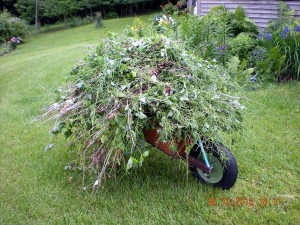Two plant scourges
Scourge #1:
This week, I spent about an hour — again — trying to fight off the garlic mustard invading the woods around my house. Garlic mustard is an invasive that spreads fast, grows high, and crowds out other woodsy plants. It’s a biennial; each plant produces hundreds of seeds which lie dormant for 20 months, and can remain viable for five years. All that adds up to a plant that’s really hard to get rid of.
Here’s what the Wisconsin Natural Resources Dept. says:
Garlic Mustard is a rapidly spreading woodland weed that is displacing native woodland wildflowers in Wisconsin. It dominates the forest floor and can displace most native herbaceous species within ten years. This plant is a major threat to the survival of Wisconsin’s woodland herbaceous flora and the wildlife that depend on it. There are two modes of spread: an advancing front, and satellite population expansion possibly facilitated by small animals. Unlike other plants that invade disturbed habitats, garlic mustard readily spreads into high quality forests.
Where did it come from? I don’t know…my infestation seemed to have coincided with roadwork and reseeding, and the horrible forest tent caterpillar invasion of a few years ago. But whether there’s a clear cause and effect link, I couldn’t say. Could the increased sunlight reaching the forest floor after the caterpillars defoliated the trees have encouraged the garlic mustard…? I think I first noticed the tall plants, which are kind of handsome, with little white flowers, the year after the caterpillar horror show. When I called the local extension office, that first year I got a “huh! I didn’t know we had that here…”
Right now, the garlic mustard is high, and the mature plants have made their seed pods…but at least at my house, the pods haven’t opened yet. So I pulled a whole bunch up, hoping to at least slow the spread.
The tall plants pull easily, but I have pretty limited optimism, depending on the source. NY Sea Grant, at Cornell, says,
Manual removal of plant has been shown to prevent the spread of garlic mustard. Pulling by hand must remove at least the upper half of the root to prevent a new stalk from forming; this is most easily accomplished in the spring when the soil is soft. Hand-pulling should be performed before seeds are formed and needs to be continued for up to five years in order to deplete any established seed bank. This method works best in smaller pockets of invasion or in areas recently invaded to help prevent the development of a seed bank.
And you’re supposed to bag the plants up and throw them in a landfill to keep the seeds out of circulation.
Scourge #2:
Late blight…I carefully dug up a volunteer potato plant and put that in a plastic bag, too. Any tiny remnant of last year’s infected potatoes can carry the blight. I took Amy Ivy’s advice and planted something else where potatoes had been last year…so there’s no confusion. If I see a potato plant there, out it goes!





.jpg)


What’s the lifespan of the garlic mustard invasion? When zebra mussels invaded the St. Lawrence River, seems like they lasted about 10 years then started fading out as they used up the available food. Does garlic mustard do something similar–like crowd itself out eventually or die off as surrounding woods gain height and canopy, blocking off sufficient sunlight? Or, is it kudzu-like…indestructible and forever expanding its habitat, adapting readily to changing environmental circumstances around it?